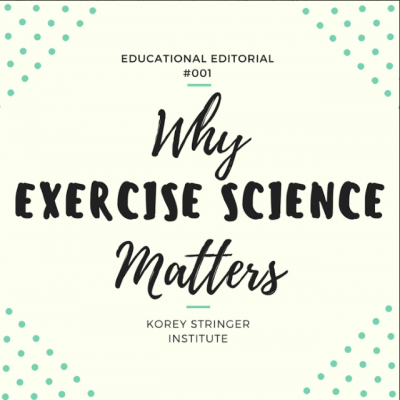By: Gabrielle Giersch M.S., Assistant Director of Education, Korey Stringer Institute

I am a Ph.D. student at the University of Connecticut in the field of exercise science. I received my Bachelor of Science Degree in Exercise Science from Roanoke College, a small liberal arts college in Virginia, and my Master’s Degree in Exercise Physiology from James Madison University. This educational background leads me to the first edition for this educational editorial series from the Korey Stringer Institute: Why Exercise Science Matters. Exercise science is a largely growing academic subject area and department in many universities. But not many people, including students that are in this major, know what to do with an exercise science degree. For many, it’s seen as a precursor for PT or PA school, and the material isn’t always taken very seriously for it’s value. It’s often seen as the in between, something one has to do to get somewhere else, not some place where many students actually want to stay.
My hope is that people see that there are so many things you can do with an exercise science degree. For example, technology is evolving to be more adept at measuring physiological variables so everyday people, not just elite athletes or coaches, can monitor their wellness, fitness, stress, sleep, and many other physiological variables. Research is constantly improving to better equip individuals with technology and provide guidance in interpreting the data properly with goals to optimize athletic performance, health, and safety. To achieve that, we analyze detailed data, from the level of microscopic molecules and genetic expressions, in combination with observations from what actually happens in the field, to make informed decisions about human physiology. Exercise science provides practitioners with the ability to directly relate the research back to the human body and its movements. This makes the education of those in exercise science even more important, particularly with regard to evidence and research based education.
For this field to advance, it is vital for everyone who is involved in exercise science to have access to evidence and research-based practices, as well as outstanding educational resources. This applies not only to the students, athletic trainers, athletes, team coaches, strength and conditioning coaches, clinical exercise physiologists, physical therapists, professors, and researchers, but, ANYONE who is partaking in physical activity, exercise, or sports. We need to spread the word about exercise science and evidence based knowledge instead of dispelling myths from previous generations (see classical heat stroke vs. exertional heat stroke). Using evidence and research can not only improve performance of elite athletes, it can also help to save lives. The American College of Sports Medicine has a global health initiative called Exercise is Medicine (http://www.exerciseismedicine.org/) which refers to the applicability of exercise and physical activity for all people. Our goal should be to use evidence to broaden our field of expertise and make this field larger and more applicable to our society as a whole. The athletic trainers, the professors, the researchers, the physical therapists, and the exercise scientists already know that it matters. I think it’s time the rest of the world did too!
The views represented in this editorial are those of the author and may not reflect the views of the Korey Stringer Institute. Statements made within this editorial should not be construed as official statements from the Korey Stringer Institute.